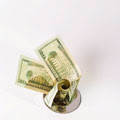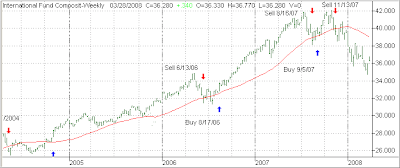 Ever since the Fed provided an assist in bailing out Bear Stearns, I’ve been wondering who might be really on the hook if things go bad. The Fed in essence guaranteed some $30 billion of Bear Stearns’ questionable assets in order to persuade JP Morgan that this purchase was the right thing to do.
Ever since the Fed provided an assist in bailing out Bear Stearns, I’ve been wondering who might be really on the hook if things go bad. The Fed in essence guaranteed some $30 billion of Bear Stearns’ questionable assets in order to persuade JP Morgan that this purchase was the right thing to do.
Bloomberg reports as follows:
Even as the Bush administration insists it won’t risk public funds in a bailout, American taxpayers may already be liable for billions of dollars stemming from Federal Reserve and Treasury efforts to quell a financial crisis.
History suggests the Fed may not recover some of the almost $30 billion investment in illiquid mortgage securities it received from Bear Stearns Cos., said Joe Mason, a Drexel University professor who has written on banking crises. Treasury’s push to have Fannie Mae and Freddie Mac buy more mortgage bonds reduces the capital the government-chartered companies hold in reserve at a time when foreclosures and defaults are surging. Senators are promising to investigate.
Officials “are playing with fire,” said Allan Meltzer, a Fed historian and economics professor at Carnegie Mellon University in Pittsburgh. “With good luck, none of these liabilities will come due. We can’t expect that good luck, and we haven’t had it.”
Fed Chairman Ben S. Bernanke and Treasury Secretary Henry Paulson were forced to respond after capital markets seized up and Bear Stearns faced a run by creditors. In an emergency action that jeopardizes the dividend it pays the Treasury, the Fed authorized a $29 billion loan against illiquid mortgage- and asset-backed securities from Bear Stearns that will be held in a Delaware corporation. JPMorgan Chase & Co. contributed $1 billion.
Senate Finance Committee Chairman Max Baucus, a Montana Democrat, and Charles Grassley of Iowa, the committee’s ranking Republican, gave Fed officials and JPMorgan executives a March 28 deadline to describe the assets involved in the transaction.
“Americans are being asked to back a brand-new kind of transaction, to the tune of tens of billions of dollars,” Baucus said in a statement today. “It’s the Finance Committee’s responsibility to pin down just how the government decided to front $30 billion in taxpayer dollars for the Bear Stearns deal, and to monitor the changing terms of the sale.”
The Delaware company will liquidate the assets over 10 years, with JPMorgan absorbing the first $1 billion in losses, with the Fed bearing any that remain. Any such losses would hurt the Fed’s balance sheet, and ultimately the taxpayer, because they would reduce the stipend the Fed pays to the Treasury from earnings on its portfolio. The dividend was $29 billion in 2006.
Sure, there is always the remote possibility that Bear Stearns’ assets can be sold at the full value they were guaranteed. However, judging by the amount of garbage subprime assets still floating around the world, chances are much greater that they are either worth less or even worthless.
In that case, an unwanted tax payer bailout would be complete. Maybe with proper juggling of the books or new and creative accounting rules, the Fed can postpone the inevitable “coming clean” for a few years.







